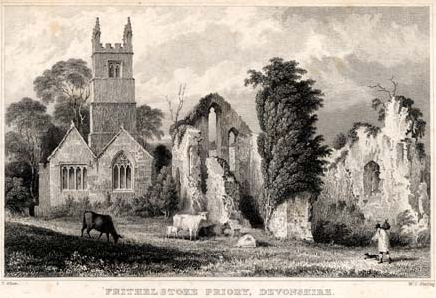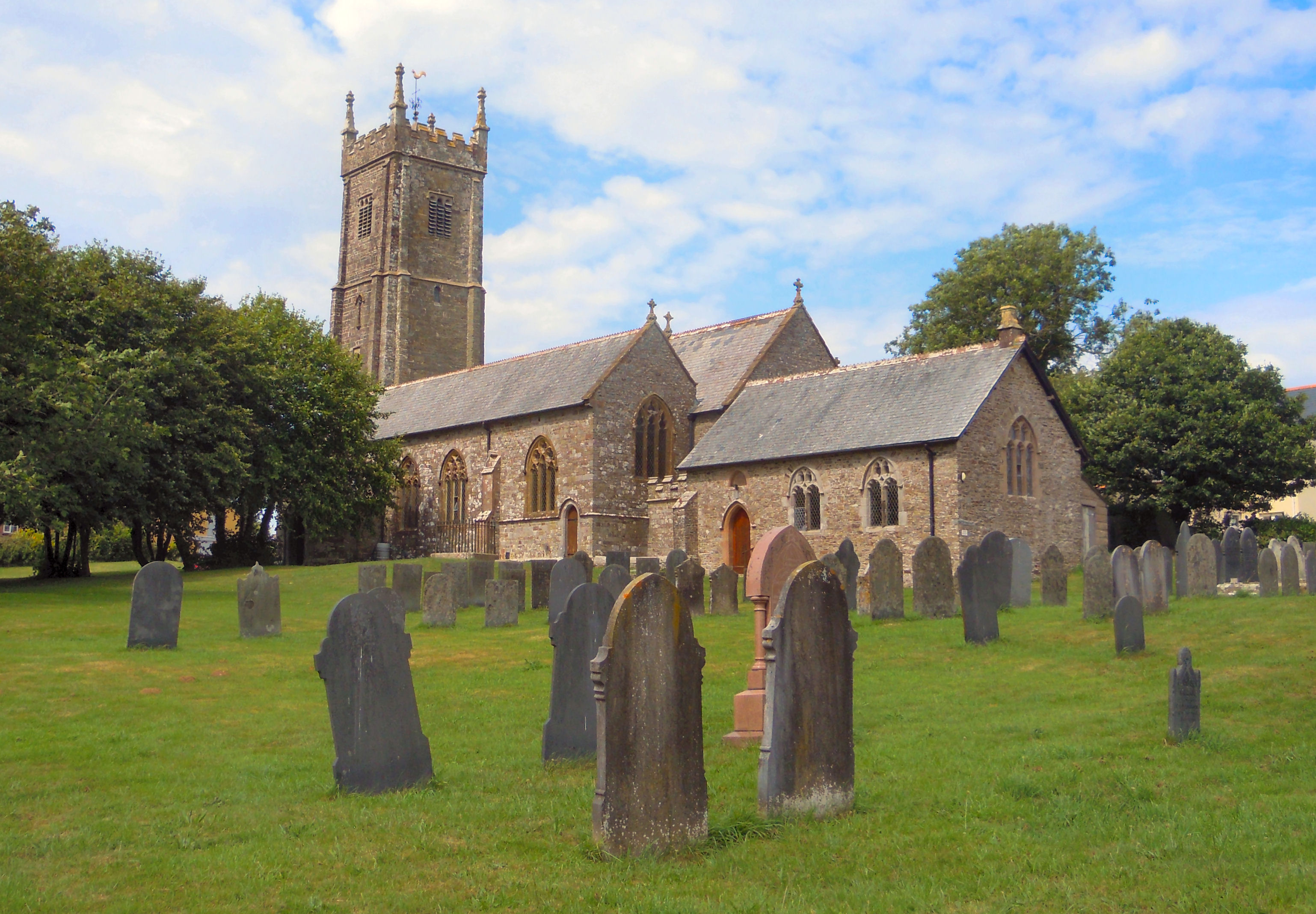|
Frithelstock
Frithelstock (pronounced ''Frizzlestock'') is a village, civil parish and former manor in Devon, England. It is located within Torridge local authority area and formed part of the historic Shebbear hundred. The parish is surrounded, clockwise from the north, by the parishes of Monkleigh, Great Torrington, Little Torrington, Langtree and Buckland Brewer. In 2001 its population was 366, down from 429 in 1901. The name derives from the Anglo-Saxon ''Frithulac's Stocc''. The ruins of Frithelstock Priory are adjacent to the north east side of the parish church of St Mary and St Gregory, and represent the only substantial remains of a monastic house in Devon. As of 2013 the village had one public house, the Clinton Arms, which since closed in 2018. The parish church of St. Mary & St. Gregory was enlarged in the 15th century and underwent a Victorian restoration in about 1870. History The Domesday Book of 1086 lists ''Frelelestoch'' as one of the seventy-nine Devonshire holdings ... [...More Info...] [...Related Items...] OR: [Wikipedia] [Google] [Baidu] |
Frithelstock Priory
Frithelstock Priory was founded in about 1220 at Frithelstock, Devon, England, by Robert de Beauchamp, Sir Robert de Beauchamp for Augustinians, Augustinian Canons Regular, as an indulgence to ensure intercessions for the repose of his soul. Walter de Stapledon, Bishop of Exeter, is considered a co-founder, for increasing the priory's endowments. The priory was dissolved in 1536 during the Dissolution of the Monasteries and only ruins remain. History The Domesday Book of 1086 lists ''Frelelestoch'' as one of the seventy-nine Devonshire holdings of Robert, Count of Mortain (–1090), the half-brother of William the Conqueror. His tenant was Robert FitzIvo, who appears to have held no other lands in the county. The manor was later held by Sir Roger de Beauchamp who, in about 1220, donated a large part of it to the Augustinians, Augustinian priory dedicated to St Gregory that he had founded within it as a dependency of Hartland Abbey in North Devon. At the Dissolution of the Mona ... [...More Info...] [...Related Items...] OR: [Wikipedia] [Google] [Baidu] |
Shebbear Hundred
Shebbear Hundred was the name of one of the thirty-two 19th century hundreds of Devon, England. The hundred of Shebbear was organized by the 13th century with many of the parishes of the ancient Domesday hundred of Merton. Accessed 25 Dec 2021.  The es in the of Shebbear were:
The es in the of Shebbear were:
|
Buckland Brewer
Buckland Brewer is a village and civil parish in the Torridge district of Devon, England, 4.7 miles south of Bideford. Historically the parish formed part of Shebbear Hundred. According to the 2001 census it had a population of 777, increasing to 794 at the 2011 census The village is part of Waldon electoral ward. The population for this at the same census was 1,679. __TOC__ Population Historical population figures show a variable trend of increased and decreased population. Torridge District Council historical data shows the following populations: * 1801: 872 * 1901: 644 * 2001: 777 Religion The parish church of St Mary and St Benedict (Church of England) is part of the benefice of the Hartland Coast Team Ministry. This falls within Hartland Deanery, in the Archdeaconry of Barnstaple. This is in the Diocese of Exeter. The church tower is over 500 years old, with a Norman stoup and doorway. There are monuments to, among others, John William Taylor of John Taylor & Co ... [...More Info...] [...Related Items...] OR: [Wikipedia] [Google] [Baidu] |
Torridge District
Torridge is a local government district in north Devon, England. Its council is based in Bideford. Other towns and villages in the district include Holsworthy, Great Torrington, Hartland, and Westward Ho!. The island of Lundy is administratively part of the district. To the south of the district bordering Cornwall, near Welcombe, the rugged coastline has a wild untouched beauty, due to its inaccessibility, but the South West Coast Path is well defined. The district is named after the River Torridge. Governance The district was formed on 1 April 1974, under the Local Government Act 1972, by the merger of the boroughs of Bideford and Great Torrington, the Northam urban district, Bideford Rural District, Holsworthy Rural District and Torrington Rural District. Torridge District Council is elected every four years, with currently 36 councillors being elected at each election. In 2007, Torridge registered the high number of opposed candidates in the country, with seven. ... [...More Info...] [...Related Items...] OR: [Wikipedia] [Google] [Baidu] |
Arthur Plantagenet, 1st Viscount Lisle
Arthur Plantagenet, 1st Viscount Lisle, KG (died 3 March 1542) was an illegitimate son of the English king Edward IV, half-brother-in-law of Henry VII, and an uncle of Henry VIII, at whose court he was a prominent figure and by whom he was appointed Lord Deputy of Calais (1533–40). The survival of a large collection of his correspondence in the Lisle Letters makes his life one of the best documented of his era. Biography Arthur Plantagenet was born between 1461 and 1475 in Calais, which was then an English possession in France. He died at the Tower of London, where he is buried. The identity of his mother is uncertain; the most likely candidate appears to be the "wanton wench" Elizabeth Wayte, although the historical record is spotty on this issue, and it is not entirely clear that Wayte is distinct from another of Edward's mistresses, Elizabeth Lucy. Another possible candidate is Elizabeth Shore. His godfather was William FitzAlan, 16th Earl of Arundel. He spent his child ... [...More Info...] [...Related Items...] OR: [Wikipedia] [Google] [Baidu] |
Demesne
A demesne ( ) or domain was all the land retained and managed by a lord of the manor under the feudal system for his own use, occupation, or support. This distinguished it from land sub-enfeoffed by him to others as sub-tenants. The concept originated in the Kingdom of France and found its way to foreign lands influenced by it or its fiefdoms. In England, Wales and Northern Ireland, royal demesne is the land held by the Crown, and ancient demesne is the legal term for the land held by the king at the time of the Domesday Book. Etymology The word derives from Old French , ultimately from Latin , "lord, master of a household" – ''demesne'' is a variant of ''domaine''. The word ''barton'', which is historically synonymous to ''demesne'' and is an element found in many place-names, can refer to a demesne farm: it derives from Old English ''bere'' (barley) and ''ton'' (enclosure). Development The system of manorial land tenure, broadly termed feudalism, was conceived in Fran ... [...More Info...] [...Related Items...] OR: [Wikipedia] [Google] [Baidu] |
Mohuns Ottery
Mohuns Ottery or Mohun's Ottery ( "moon's awtrey"),Gover, J.E.B., Mawer, A. & Stenton, F.M. (1931). ''The Place-Names of Devon''. English Place-Name Society. Vol viii. Part II. Cambridge University Press. p.642 is a house and historic manor in the parish of Luppitt, 1 mile south-east of the village of Luppitt and 4 miles north-east of Honiton in east Devon, England. From the 14th to the 16th centuries it was a seat of the Carew family. Several manorial court rolls survive at the Somerset Heritage Centre, Taunton, Somerset.Somerset Heritage Centre, Taunton, ref DD\HLM/7 Box 7: Deeds for Luppitt, etcCopies of court roll, 1654–1683 and Leases for 99 years and lives, 1628–1763 for properties holden of the manor of Mohun's Ottery, etc./ref> The old manor house burnt down in 1868 and was completely rebuilt as a farmhouse, categorised as a grade II listed building since 1955. The ruins of a mid-16th century gatehouse lie to the south of the house; these and the adjoining garden wa ... [...More Info...] [...Related Items...] OR: [Wikipedia] [Google] [Baidu] |
Robert Walpole
Robert Walpole, 1st Earl of Orford, (26 August 1676 – 18 March 1745; known between 1725 and 1742 as Sir Robert Walpole) was a British statesman and Whig politician who, as First Lord of the Treasury, Chancellor of the Exchequer, and Leader of the House of Commons, is generally regarded as the ''de facto'' first Prime Minister of the United Kingdom, Prime Minister of Great Britain. Although the exact dates of Walpole's dominance, dubbed the "Robinocracy", are a matter of scholarly debate, the period 1721–1742 is often used. He dominated the Walpole–Townshend ministry, as well as the subsequent Walpole ministry, and holds the record as the List of prime ministers of the United Kingdom by length of tenure, longest-serving British prime minister. W. A. Speck wrote that Walpole's uninterrupted run of 20 years as prime minister "is rightly regarded as one of the major feats of British political history. Explanations are usually offered in terms of his expert handling of ... [...More Info...] [...Related Items...] OR: [Wikipedia] [Google] [Baidu] |
Robert Walpole, 2nd Earl Of Orford
Robert Walpole, 2nd Earl of Orford, KB (1701 – 31 March 1751), was a British peer and politician, styled Lord Walpole from 1723 to 1745. Origins He was the eldest son of Sir Robert Walpole (1676–1745), the King's First Minister, now regarded as the first British Prime Minister, by his first wife Catherine Shorter. In 1723 his father declined a peerage for himself but did accept the offer on behalf of his 22-year-old son Robert who was thus raised to the peerage as Baron Walpole, of Walpole in the County of Norfolk. Marriage Circa 26 March 1724 Lord Walpole married the 15-year-old heiress Margaret Rolle (1709–1781), the only surviving daughter of Colonel Samuel Rolle (1646–1719), of Heanton Satchville, Petrockstowe. Margaret was the heiress to a junior branch of the great Rolle family of Stevenstone in Devon and to her paternal grandmother, born Lady Arabella Clinton, an aunt and co-heiress of her nephew Edward Clinton, 5th Earl of Lincoln and 13th Baron Clinton ... [...More Info...] [...Related Items...] OR: [Wikipedia] [Google] [Baidu] |
Augustinians
Augustinians are members of Christian religious orders that follow the Rule of Saint Augustine, written in about 400 AD by Augustine of Hippo. There are two distinct types of Augustinians in Catholic religious orders dating back to the 12th–13th centuries: * Various congregations of Canons Regular also follow the Rule of Saint Augustine, embrace the evangelical counsels and lead a semi-monastic life, while remaining committed to pastoral care appropriate to their primary vocation as priests. They generally form one large community which might serve parishes in the vicinity, and are organized into autonomous congregations. * Several orders of friars who live a mixed religious life of contemplation and apostolic ministry. The largest and most familiar is the Order of Saint Augustine (OSA), founded in 1244 and originally known as the Hermits of Saint Augustine (OESA). They are commonly known as the Austin Friars in England. Two other orders, the Order of Augustinian Recollec ... [...More Info...] [...Related Items...] OR: [Wikipedia] [Google] [Baidu] |
Margaret Rolle, 15th Baroness Clinton
Margaret Rolle, 15th Baroness Clinton ''suo jure'' (17 January 1709 – 13 January 1781), was a wealthy aristocratic Devonshire heiress, known both for eccentricity and her extramarital affairs. By her first husband Robert, 1st Baron Walpole, later 2nd Earl of Orford (1701–1751) and eldest son of Sir Robert Walpole, she gave birth to a legitimate heir, George Walpole, 3rd Earl of Orford, who succeeded her in the title of Baron Clinton. Family background The only surviving daughter and sole heiress of Samuel Rolle, MP (1646–1719), of Heanton Satchville, Petrockstowe, by his second wife, Margaret, daughter of Roger Tuckfield, of Raddon Court, Devon, a junior branch of the Tuckfield family of Little Fulford, near Crediton, she inherited from her uncle, Roger Tuckfield, MP for the family's pocket borough of Ashburton, following the purchase of the manor of Ashburton in 1702. The Rolle family of Heanton Satchville was a wealthy cadet branch of the Rolles of Stevens ... [...More Info...] [...Related Items...] OR: [Wikipedia] [Google] [Baidu] |





